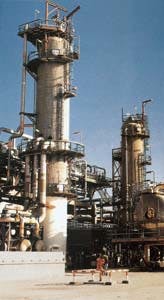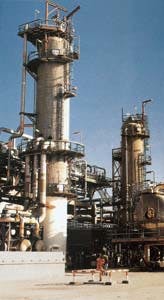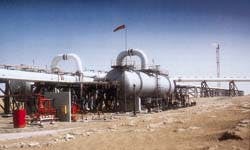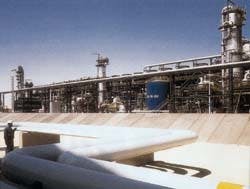Bob Tippee
Managing Editor-Economics and Exploration
The role of natural gas is growing not just in the global energy consumption mix but also in the investment plans of major oil producers.
One leading oil exporter to which gas has long been important recently adjusted its strategy to capitalize even more on the potential of light hydrocarbons.
Abu Dhabi, which has liquefied and exported natural gas from offshore fields since 1977, has placed onshore gas reserves at the center of its strategies for production, processing, and domestic energy use.
In addition to helping meet the fuel requirements of a rapidly industrializing desert emirate, gas produced from onshore fields will feed a growing petrochemical industry in Abu Dhabi and increasingly be injected into condensate and oil reservoirs to boost production.
Abu Dhabi National Oil Co. (Adnoc) expects condensate production capacity onshore to more than double to 280,000 b/d by 2000. It has made condensate processing a priority in its planned expansion and upgrade of the 135,000 b/d refinery at Ruwais.
A picture of the emirate's evolving gas industry emerged during the Middle East Petroleum and Gas Conference earlier this year in Abu Dhabi.
Supply, demand patterns
Nonassociated gas accounts for a growing share of Abu Dhabi's total gas production. Associated production, limited by the Organization of Petroleum Exporting Countries quota of 2.16 million b/d for oil produced in all of the United Arab Emirates, has been steady at about 1.5 bscfd since 1991 (Fig. 1).
For the first time, nonassociated production exceeded associated gas flow last year. Flaring was less than 5% of total output (Fig. 2).
About 45% of Abu Dhabi's gas reserves volume, which makes up most of the 205 tcf unofficially estimated for the U.A.E., is associated with oil. Gas cap volumes account for 24% of total reserves, free gas 31%. Adnoc's gas development plans focus on free gas reserves.
In 1996, when Abu Dhabi's average gas consumption reached 3 billion scfd, exports accounted for 43% of total gas use, industry 4%, water desalination and electricity generation 18%, injection 21%, and oil and gas field uses-including flaring, fuel, and shrinkage-14%.
Abu Dhabi Co. for Onshore Operations (ADCO), in which Adnoc is majority shareholder, now recycles gas produced from two condensate reservoirs to maintain pressure. Recycling is to begin in two more condensate reservoirs by 1999.
Recycling will continue as long as value of the resulting condensate exceeds that of the recycled gas. Adnoc doesn't include recycled volumes in its gas production figures.
ADCO has begun gas injection for oil recovery in Bab South and Bu Hasa North fields and is studying other injection projects. Officials expect injection into oil and condensate reservoirs to become Abu Dhabi's most significant gas consumption sector.
Economic growth and urbanization will keep gas demand growth high for power generation and water desalination. And projects at Ruwais, about 250 km west of Abu Dhabi City, will raise industrial gas use to nearly 400% of current levels by 2003. Planned and approved projects will add 600 MMscfd to total demand, and other projects are under study.
Abu Dhabi's gas exports include 5 million metric tons/year of LNG from Das Island and liquid petroleum gas from the liquefaction facility and a fractionation plant at Ruwais. Condensate produced offshore is blended with crude oil and exported.
Condensate expansion
Until 1995, Adnoc's production of condensate fluctuated between 17,000 b/d and 31,000 b/d and depended on seasonal gas production.
Completion last year of the first phase of Adnoc's Onshore Gas Development (OGD) project raised average condensate production for 1996 to 94,000 b/d and production capacity at existing onshore gas plants, operated by Abu Dhabi Gas Industries Ltd. (Gasco), to 130,000 b/d. Gasco is a joint venture of Adnoc, with a 68% share, Shell Gas BV and Total 15% each, and Partex Gas Corp. 2%.
First-phase OGD work, which ADCO handled on behalf of Adnoc along with its own Thamama B gas injection project, expanded gas treatment and liquids extraction capacities at Habshan, near giant Bab oil and gas field. The project added two 350 MMscfd trains to treat and process associated gas from Bab's lower Cretaceous Thamama B reservoir and nonassociated gas from the Thamama C reservoir and a 625 MMscfd train for rich nonassociated gas from the Thamama F reservoir. The work also added compression for as much as 830 MMscfd of gas for injection into Thamama F.
Work on the project last year included drilling of 38 gas producers and 18 gas injectors and installation of five remote manifold stations and a sweet gas distribution network.
Gas injection began in July 1996 in Bab North and reached 72 MMscfd in December, adding 20,000 b/d to oil production. ADCO last year completed three fiber glass observation wells in two pilot gas injection areas in the northern and southern Bab areas.
Processing facilities at Habshan now have total inlet capacity of 1.865 bcfd. First-phase OGD facilities increased output of natural gas liquids (NGL) by 4,500 metric tons/day. The NGL moves through a 227 km pipeline to Gasco fractionation facilities at Ruwais.
A second OGD phase will increase condensate production capacity by 50,000 b/d and add 1 bcfd of sales gas capacity by 2000.
A project at Asab oil and gas field, 90 km southeast of Bab, will add 100,000 b/d of condensate production capacity, with inlet capacity of nearly 825 MMcfd of associated gas, by 1999. The condensate will be processed at Ruwais and the residue gas injected into Asab reservoirs.
ADCO plans to boost Asab's crude oil production capacity by 50,000 b/d by the end of 1998 through horizontal recompletions of inactive wells.
Supplementing onshore gas supplies will be more than 500 MMcfd of gas from the Permian Khuff formation of offshore Abu Al Bukhoosh and Umm Shaif fields. Raw gas from Abu Al Bukhoosh will travel through a new 115 mile pipeline and from Umm Shaif through a new 26 mile line for processing onshore at Taweelah. This gas has been considered for export through a possible new pipeline to Dubai (OGJ, Feb. 3, 1997, p. 32).
Refinery upgrade
At present, condensate produced onshore is exported from Ruwais. New refinery units will use it as feedstock for unleaded gasoline and other products. Condensate produced offshore will continue to be exported with crude.
The refinery expansion includes installation of condensate processing capacity totaling 280,000 b/d and the eventual doubling of crude capacity.
The first phase of the project will add two 140,000 b/d condensate processing trains with attendant kerosine sweetening units and naphtha stabilizers. The trains are to enter service 6 months apart during 1999. Following them into service as part of the first phase will be naphtha and gas oil hydrotreaters, a 27,500 b/d catalytic reformer with provision for future paraxylene production, and a 25,000 b/d isomerization unit.
The second phase of the refinery expansion will include a 135,000 b/d crude train, a hydrocracker, gas oil hydrotreaters, residue upgrading and associated downstream units to handle about 36,000 b/d of vacuum resid, and offsites and utility facilities.
Addition of a complex capable of producing 800,000 tons/year of paraxylene is possible to help Adnoc take advantage of the high naphtha content of Abu Dhabi's condensate. Feed would be reformate not needed for production of unleaded gasoline. Streams remaining after xylene removal could reenter the gasoline pool.
Petrochemical plans
With growing volumes of light hydrocarbons becoming available at Ruwais, Adnoc plans to expand its activities into olefins production.
In addition to the refinery and Gasco fractionation plant, facilities at Ruwais now include a 4,200 ton/day sulfur granulation and handling terminal and a Ruwais Fertilizer Industries (Fertil) plant, which exports 600,000 tons/year of urea and surplus ammonia. Fertil is a member of the Adnoc group of companies.
Adnoc will use ethane in tail gas at the Gasco plant as feedstock for production of ethylene and polyethylene. Gasco now uses the gas as fuel.
Adnoc last year entered a joint venture with Borealis AS, Copenhagen, to build a complex at Ruwais capable of producing 450,000 tons/year of high density and linear low density polyethylene (OGJ, Feb. 24, 1997, p. 40). Start-up is scheduled late in 2000.
Abu Dhabi's Supreme Petroleum Council has approved expansion of the ethylene cracker to 600,000 tons/year from 450,000 tons/year, expandable to 750,000-900,000 tons/year. Adnoc is studying propane as a supplementary feedstock.
A new ethylene dichloride (EDC) complex at Ruwais will use the extra 150,000 tons/year of ethylene produced by the joint venture and salt from a recently discovered dome at Jebel Al Dhanna to produce 520,000 tons/year of EDC and 430,000 tons/year of sodium hydroxide. Commissioning of the EDC complex is planned for 2001.
The EDC plant will provide chlorine and salt for local consumption and hydrogen for the Ruwais refinery.
Also at Ruwais, Fertil is considering doubling its capacity to produce urea.
Copyright 1997 Oil & Gas Journal. All Rights Reserved.





